The president’s budget proposal – the official document that lays out his administration’s tax and spending wish list – usually contains a mix of dubious economic assumptions and ambitious policy ideas that are dead on arrival in Congress. But while the president’s budget is usually somewhat estranged from reality, Donald Trump’s Fiscal Year 2019 Budget is utterly divorced from it. The budget proposal also guts critical public investments such as infrastructure and scientific research, slashes the social safety net, and – even under the most charitable economic assumptions – still proposes to run budget deficits significantly larger than they would have been under President Obama’s final budget proposal.
Gutting Public Investment
 The delusion starts with a proposal for discretionary spending levels far below those in the budget deal passed just last week. That deal set spending caps for non-defense (domestic) discretionary programs to $579 billion in FY2018, which is just under 2.9 percent of gross domestic product. This represented a significant increase over the caps imposed by the Budget Control Act of 2011 but would still result in domestic spending below its historical average.
The delusion starts with a proposal for discretionary spending levels far below those in the budget deal passed just last week. That deal set spending caps for non-defense (domestic) discretionary programs to $579 billion in FY2018, which is just under 2.9 percent of gross domestic product. This represented a significant increase over the caps imposed by the Budget Control Act of 2011 but would still result in domestic spending below its historical average.
The Trump budget, by contrast, would radically lower these caps at a time when Congress seems more inclined to increase them. As this chart shows, the domestic discretionary caps proposed in the Trump budget would fall to less than half the levels – both in dollars and as a share of the economy – that they would be if Congress continued growing spending at the rate they did in last week’s deal. While Trump’s budget did include an addendum to reflect the higher spending levels, it is still noteworthy that he would have proposed a budget so divorced from the political realities in Congress – especially when that Congress is controlled by members of his own party.
Trump’s desire for sharp cuts to domestic discretionary spending are deeply problematic when one considers the programs it funds. Discretionary spending is the part of the budget that Congress has the flexibility to appropriate annually, and the non-defense portion includes critical public investments such as infrastructure and scientific research that contribute to the long-term health of our economy. 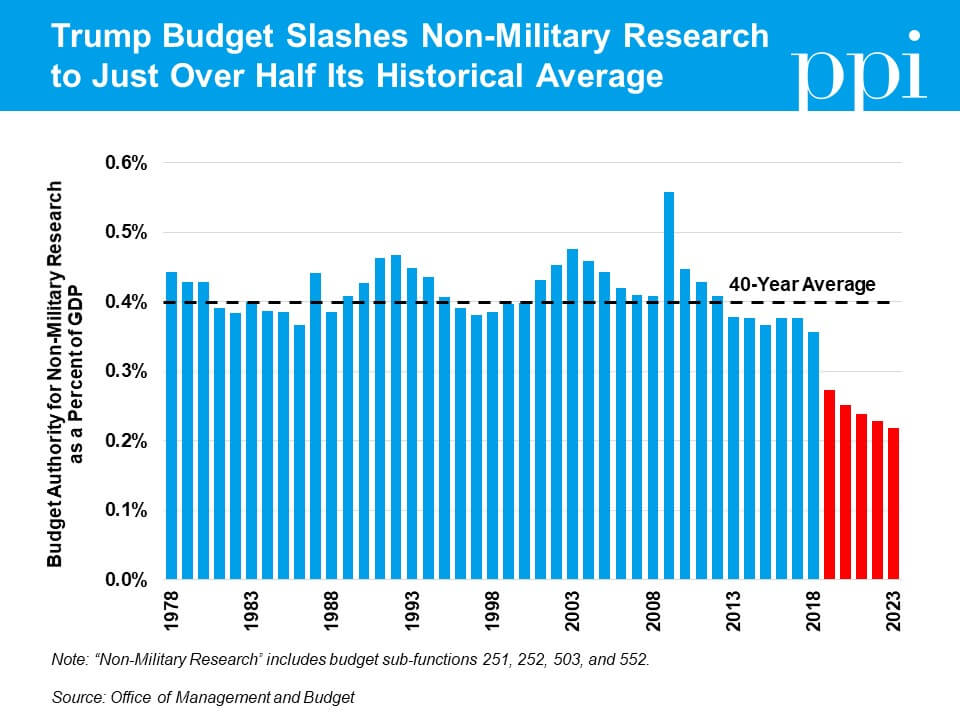 The next chart depicts the Trump budget’s steep cuts to these investments, slashing the share of spending for non-military research to just over half its historical average by 2023.
The next chart depicts the Trump budget’s steep cuts to these investments, slashing the share of spending for non-military research to just over half its historical average by 2023.
It is not surprising that the Trump administration – the most anti-science in recent memory – would propose deep cuts to scientific research. What should be surprising, however, is that even the kinds of domestic public investment that Trump ostensibly supports would suffer under his budget proposal.
Trump’s budget was accompanied by a “$1.5 trillion” proposal to boost investment in infrastructure over the next ten years. The details, however, reveal that this “plan” amounts to little more than empty Trump bluster. The administration suggested using $200 billion in federal investment to somehow leverage an additional $1.3 trillion from cash-strapped state and local governments, as well as the private sector. But where exactly would this $200 billion come from? 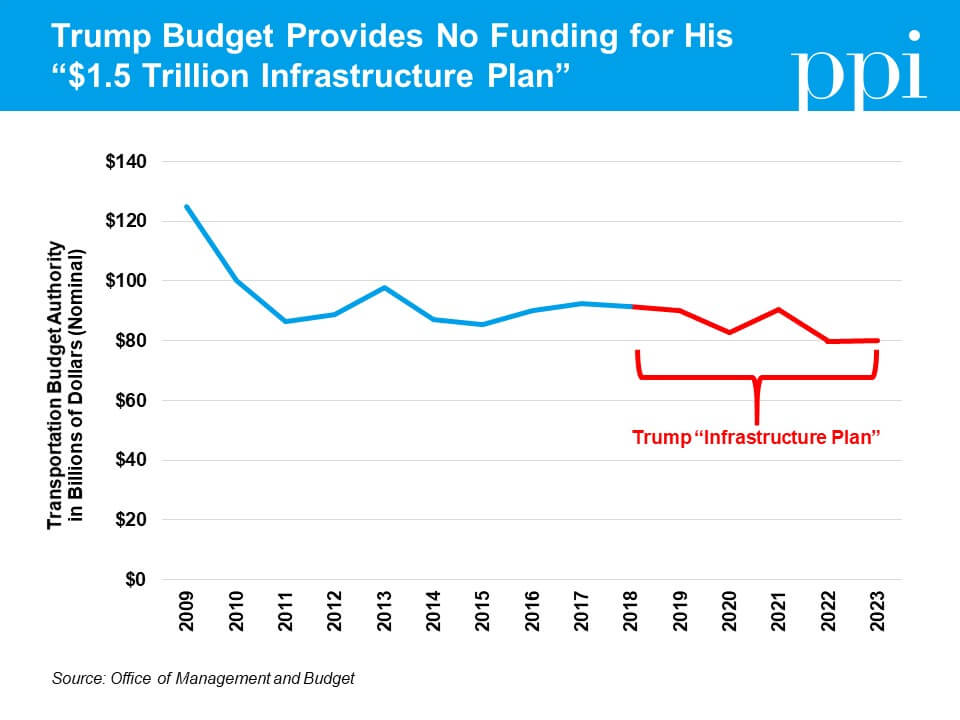 Cuts to existing infrastructure programs.
Cuts to existing infrastructure programs.
Transportation spending, for example, would fall under the Trump budget over the next 5 years. And to be clear: the issue isn’t just that it would fall as a percentage of the economy, or that it wouldn’t keep up with inflation – the following chart shows that the Trump budget actually proposes a reduction in nominal dollars spent on transportation infrastructure. The expectation that billions of dollars in hard cuts to federal investment will spur trillions of dollars in outside spending is outlandish.
These cuts to domestic discretionary spending should be considered in the context of what the budget proposes for mandatory spending as well. Mandatory spending is the part of the budget that that grows on autopilot because spending is determined by previously established formulas. Unlike discretionary spending, some mandatory programs are projected to grow much faster than the economy under current law and are greatly in need of reform if they are going to be sustainable over the long-term. Unfortunately, most of the reforms proposed in the Trump budget are precisely the wrong ones.
Slashing the Safety Net While Deepening Deficits
The two largest – and fastest growing – mandatory spending programs are Social Security and Medicare. Demographic pressures caused by the aging of the baby boomer generation are resulting in program spending that grows faster than the dedicated revenue needed to finance it. There have been many proposals with bipartisan support to curb the growth of these programs without impacting vulnerable beneficiaries who depend on them most. Unfortunately, the Trump administration eschewed any major Social Security reforms and included only modest proposals to rein in the growth of Medicare.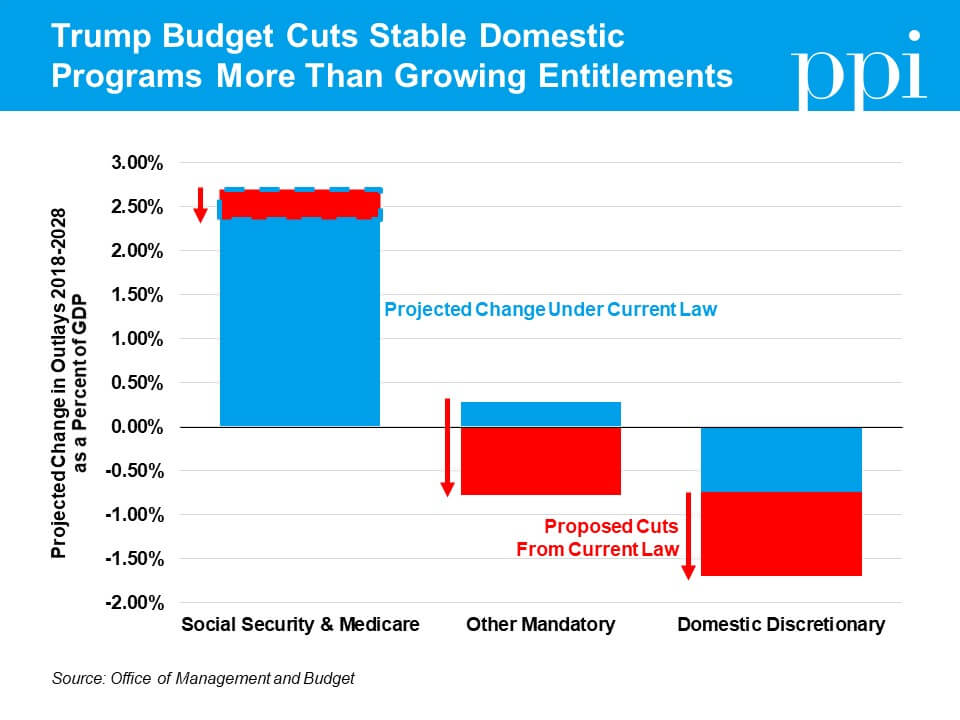
The mandatory reforms the Trump budget did propose take the form of deep cuts to vital safety net programs that serve the most vulnerable in our society. Spending on the Temporary Assistance for Needy Families and Supplemental Nutrition Assistance Programs would be cut by 13 and 31 percent, respectively. Other programs, including many that assist lower- and middle-income Americans with housing costs, are eliminated entirely. Altogether, the Trump budget proposes to cut spending on safety net programs by over $1 trillion throughout the next decade – at least two-thirds of which would come from cuts to Medicaid and the Affordable Care Act that Congress rejected several times last year.
Trump’s approach is particularly wrong-headed given that mandatory spending outside of Social Security and Medicare is growing at roughly the same rate as the economy under current law. The Trump administration is avoiding addressing the real drivers of our deficit – demographic changes and his administration’s reckless tax cuts – and instead using it as a pretext for deep cuts in critical public investments and vital safety net programs. 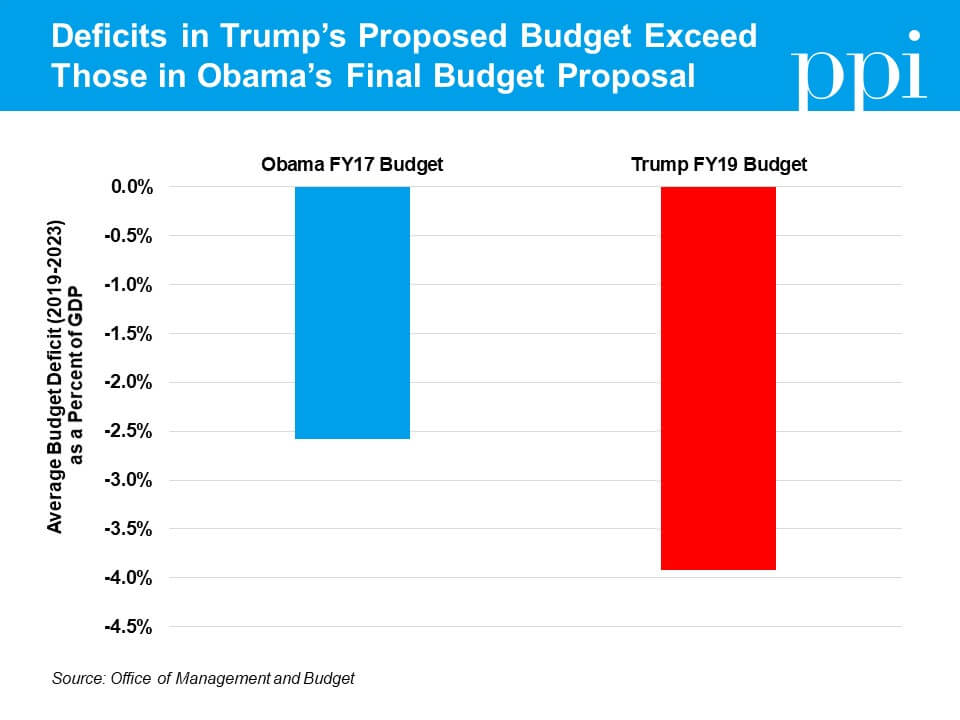 The result is that Trump’s latest budget, in his own OMB’s assessment, leads to significantly larger budget deficits over the next five years than those proposed in President Obama’s final budget over the same period (2019-2023).
The result is that Trump’s latest budget, in his own OMB’s assessment, leads to significantly larger budget deficits over the next five years than those proposed in President Obama’s final budget over the same period (2019-2023).
This comparison, however, assumes OMB’s economic projections are correct. The final, and perhaps most, absurd aspect of the Trump budget is its economic assumptions. The budget projects real economic growth that is nearly 50% higher than those of other independent experts. Unreasonably high growth projections mask deficits by depicting higher tax revenues, lower spending on safety net programs, and a bigger GDP estimate that makes the deficit look smaller as a percentage.
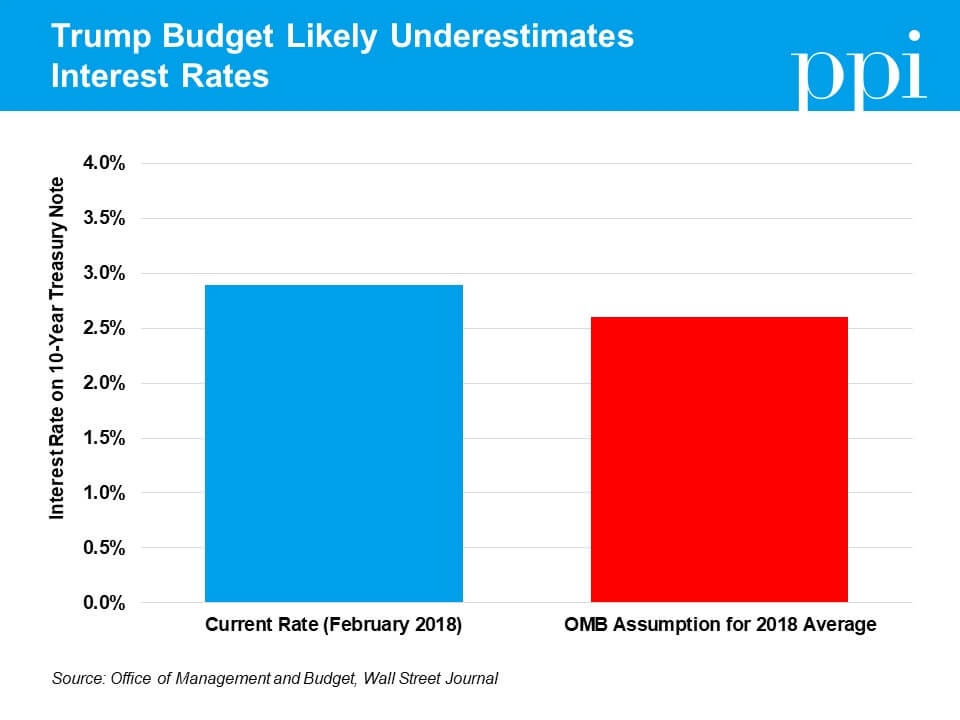 OMB also understates the impact of deficits under the Trump budget proposal with its interest rate projections. OMB estimates the average interest rate on a 10-year Treasury Note in 2018 will be 2.6 percent. But the rate on this form of government debt already exceeds 2.9 percent and is continuing to rise rapidly following the passage of Trump’s budget-busting tax bill. This is exactly what economists would expect in a healthy economy such as the one we face today, as large budget deficits force the government to increasingly compete with the private sector for capital.
OMB also understates the impact of deficits under the Trump budget proposal with its interest rate projections. OMB estimates the average interest rate on a 10-year Treasury Note in 2018 will be 2.6 percent. But the rate on this form of government debt already exceeds 2.9 percent and is continuing to rise rapidly following the passage of Trump’s budget-busting tax bill. This is exactly what economists would expect in a healthy economy such as the one we face today, as large budget deficits force the government to increasingly compete with the private sector for capital.
Under more realistic assumptions, the budget deficits in Republican Donald Trump’s budget proposal could be more than double those in the final one offered by Democratic President Barack Obama. When that budget was released, Republicans including House Speaker Paul Ryan rejected it while saying: “We need to tackle our fiscal problems before they tackle us.” Two years later, the only thing this absurd Trump budget tackles is any pretense that those concerns were sincere.
Billy Stampfl contributed to this post. This post has been edited to remove an extrapolation based on recent interest rate spikes.